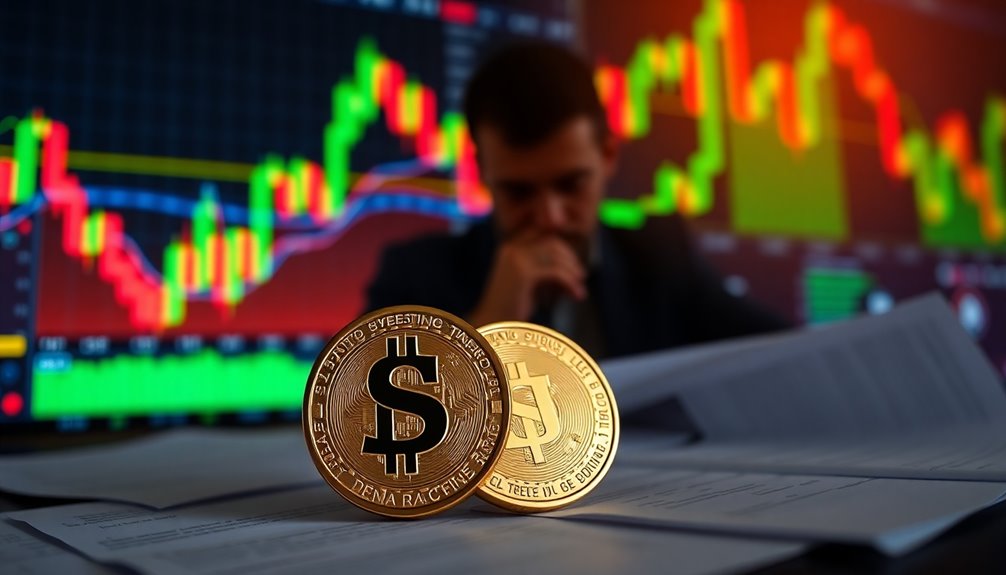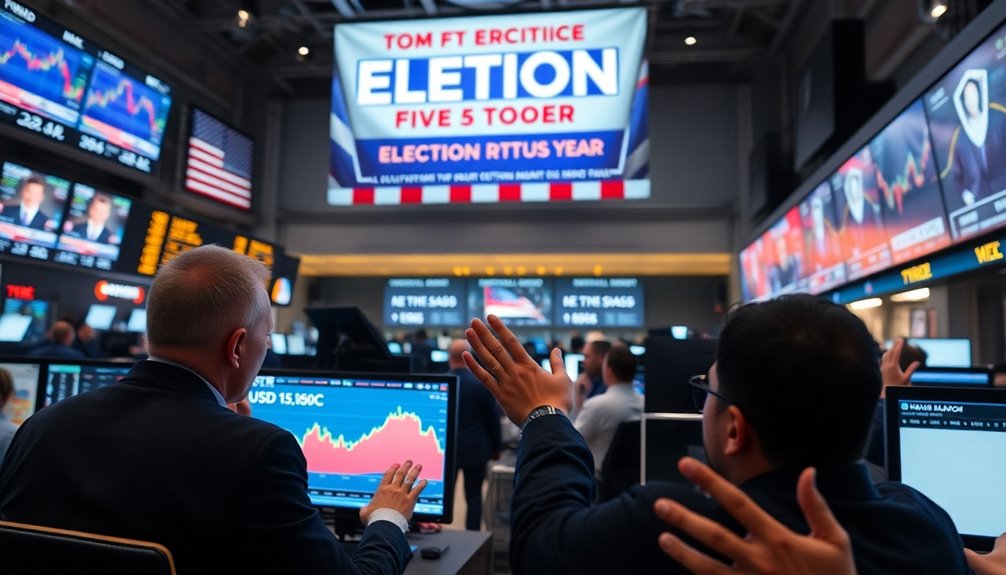Yes, USDT is losing ground, primarily due to stricter MiCA regulations that emphasize compliance and transparency. As USDT faces delistings and regulatory scrutiny, USDC has gained traction, especially in Europe. Its trading volumes have soared to $23 billion in 2024 as it adheres to these new standards, presenting itself as a safer alternative. This shift is fueled by growing corporate adoption and changing market dynamics in the stablecoin landscape. With USDT's market cap declining significantly and regulatory pressures mounting, the landscape is shifting rapidly. If you want to understand the broader implications of these changes, keep exploring.
Key Takeaways
- MiCA regulations impose strict compliance requirements, leading to increased trading volumes for USDC while USDT faces delisting from European exchanges.
- USDT's market cap has significantly decreased, dropping from $141 billion to approximately $83 billion due to compliance concerns.
- Ongoing investigations and transparency issues surrounding Tether raise doubts about USDT's operational model and sustainability in a regulated environment.
- USDC's compliance with MiCA regulations positions it as a safer and more attractive alternative for corporate adoption and DeFi applications.
- As regulatory clarity improves, USDC is emerging as a dominant stablecoin, particularly in the EU market, challenging USDT's previous dominance.
Regulatory Shifts Impact Stablecoins

As regulatory shifts unfold, stablecoins like USDT and USDC are feeling the impact more than ever.
The introduction of MiCA regulations has created strict requirements for stablecoin issuers, forcing them to hold significant reserves in liquid, low-risk assets. This has led to USDT's delisting from European exchanges, reducing its liquidity and market share.
Meanwhile, USDC and FDUSD are thriving, seeing trading volumes soar to $23 billion in 2024, thanks to their compliance with these regulations. Additionally, the rise of decentralized finance (DeFi) applications is further encouraging the adoption of compliant stablecoins like USDC.
This shift is reshaping the landscape, with USDC emerging as a dominant player globally, particularly in the Solana market.
The evolving regulatory environment is clearly driving a transition in user preference and market dynamics, leaving USDT struggling to keep pace.
Recent USDT Regulatory Challenges

The regulatory landscape for USDT is becoming increasingly fraught with challenges, particularly as uncertainty surrounding its compliance with the new MiCA regulations grows. European regulators haven't clarified whether USDT meets these standards, leaving you and others in the market uncertain. Coinbase's decision to delist USDT from its European services highlights these compliance concerns, while major platforms like Binance and Crypto.com take a more cautious, wait-and-see approach. Tether's limited transparency regarding reserves raises further doubts about its operational model and its ability to adapt. Meanwhile, ongoing U.S. investigations add to the regulatory pressure. As USDC gains traction with clear compliance, USDT faces significant hurdles that could disrupt its standing in the market. Additionally, Tether is now required to hold 60% of reserves in EU banks, further complicating its operations.
Stablecoin Market Volatility

While navigating the evolving landscape of stablecoins, you'll find that market volatility is significantly influenced by regulatory changes and competition among issuers.
The recent MiCA regulations have imposed strict compliance requirements, prompting nearly $4 billion in USDT redemptions ahead of their implementation.
As USDC gains traction in the EU due to its compliance, it challenges USDT's dominance. Additionally, the stablecoin market capitalization is expected to reach $400 billion by 2025, driven by growing digital payment acceptance, which further intensifies competition.
Yield-bearing alternatives like USDe also lure users away from Tether.
As clarity in regulations increases, anticipate a surge in stablecoin supply, which could further contribute to market volatility and shift dynamics among established players.
Corporate Integration of Stablecoins

Corporate integration of stablecoins is transforming the financial landscape, enabling businesses to streamline their operations and enhance payment efficiency.
With MiCA regulations in place, companies can now ensure compliance, giving them a competitive edge. USDC, compliant with these regulations, is becoming the preferred choice for startups in the EU, while USDT struggles with compliance issues. The growing adoption of stablecoins as a payment method reflects their significance in the financial landscape, making them increasingly attractive to businesses.
By integrating stablecoin orchestration, businesses can reduce transaction costs and improve payment processes without major changes.
Popular payment processors like Stripe are making it easier for companies to adopt these solutions, allowing seamless transactions and lower fees.
As businesses increasingly recognize the benefits, stablecoins are becoming a crucial part of the corporate payment ecosystem, fostering trust and stability in financial operations.
Election Year Market Reactions

As businesses increasingly adopt stablecoins like USDC for their operations, the broader crypto market is feeling the effects of the upcoming election year.
With USDT's market cap declining over 1% amid MiCA compliance issues, investor sentiment is shifting. Tether's reluctance to meet regulatory requirements raises concerns, prompting many to reevaluate their positions. Recent reports indicate that USDT's market cap has seen a significant decline from $141 billion to approximately $83 billion, highlighting the challenges it faces.
USDC, now compliant with MiCA, is gaining traction as a safer alternative. Additionally, exchanges are responding by delisting USDT for European users, leading to increased trading costs and a shift toward fiat pairs.
As political support for pro-crypto policies emerges, regulatory clarity may reshape the landscape, further impacting USDT and bolstering USDC’s rise in the market. The growing acceptance of cryptocurrencies within mainstream finance could lead to increased adoption among retail investors, as they seek safer and more stable options. Furthermore, the discussions surrounding “senator warren on crypto regulations” highlight the need for a balanced approach that encourages innovation while ensuring consumer protection. As these regulatory frameworks evolve, investors will likely gravitate towards assets that offer greater transparency and security, potentially enhancing the market dominance of stablecoins like USDC.
Regulatory Trends Shaping Stability

Regulatory trends are significantly shaping the landscape of stablecoins, particularly with the introduction of the Markets in Crypto-Assets (MiCA) framework in the EU.
You'll notice that MiCA imposes strict compliance requirements, forcing issuers to secure an e-money license and maintain a substantial portion of reserves in independent banks. This has led to the delisting of USDT from exchanges like Coinbase, creating uncertainty and fear among investors. The rise of automation in data analysis could also play a role in how quickly changes in market sentiment are understood and acted upon.
As USDT's market value drops, USDC emerges as a compliant alternative, gaining market preference. The high reserve ratios mandated by MiCA, such as 30% for regular stablecoins, further enhance USDC's appeal among investors seeking stability.
With MiCA setting a precedent for global standards, the future of stablecoin regulation will likely demand stringent governance and transparency, impacting how you view and utilize these digital assets in the evolving market landscape.
Frequently Asked Questions
What Are the Main Differences Between USDT and USDC?
When you compare USDT and USDC, the main differences lie in their market capitalization, transparency, and reserve assets.
USDT boasts a larger market cap, making it more popular among traders. However, it lacks transparency in its reserves, which raises concerns.
USDC, on the other hand, prioritizes regulatory compliance and transparency, primarily backed by cash and U.S. Treasuries, making it increasingly favored among institutional investors.
Their adoption and usage also reflect these differences.
How Do Stablecoins Affect Cryptocurrency Market Stability?
Stablecoins are like the anchor in a turbulent sea, providing stability to the cryptocurrency market. They facilitate trade, enhance liquidity, and serve as a safer store of value.
When you engage in crypto trading, stablecoins help you navigate price volatility by offering a reliable medium.
However, if a major stablecoin collapses, it could unleash chaos, drying up liquidity and shaking investor confidence, ultimately destabilizing the entire ecosystem you rely on.
Can Stablecoins Be Used for International Transactions?
Absolutely, you can use stablecoins for international transactions. They offer near-instantaneous settlements and eliminate the long processing delays typical of traditional banking.
With lower transaction fees and simplified payment processes, you'll save money, especially on smaller transactions.
Plus, the security and transparency of blockchain technology ensure your transactions are safe and traceable.
What Is the Role of Collateral in Stablecoins?
Imagine a sturdy bridge made of various materials, each representing different types of collateral in stablecoins.
You walk across fiat-backed bridges, knowing they're supported by real currency. As you explore, you encounter crypto-backed paths, where you lock in your assets.
Algorithmic bridges adjust themselves based on traffic, while commodity-backed routes rely on tangible goods.
Each form of collateral plays a crucial role, ensuring stability and trust as you navigate the landscape of digital currency.
How Do Interest Rates Impact Stablecoin Adoption?
Interest rates significantly impact your stablecoin adoption.
When rates are low, you might find stablecoins attractive due to reduced yields on traditional savings. However, high rates can draw you back to traditional assets, as they offer better returns. This shift can lead to decreased market capitalization for stablecoins.
Despite these fluctuations, stablecoin usage continues to grow, driven by their efficiency in transactions and expanding regulatory clarity, which makes them increasingly appealing.
Conclusion
In the ever-changing landscape of stablecoins, it's clear that USDT's dominance is being challenged by regulatory shifts and the rise of USDC. As the saying goes, "the only constant is change." Staying informed about these developments is crucial for anyone involved in the crypto market. With regulations evolving and market dynamics shifting, adapting to these changes can help you navigate the uncertain waters ahead and make more informed decisions about your investments.









